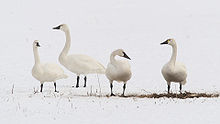Whistling swan
| Whistling swan | ||||||||||||
|---|---|---|---|---|---|---|---|---|---|---|---|---|

Whistling Swan ( Cygnus columbianus ) |
||||||||||||
| Systematics | ||||||||||||
|
||||||||||||
| Scientific name | ||||||||||||
| Cygnus columbianus | ||||||||||||
| ( Ord , 1815) |
The tundra swan ( Cygnus columbianus ) is a bird art from the genus of swans ( Cygnus ), and the family of the Anatidae (Anatidae).
Sometimes in the will tundras of Eurasia breeding Tundra Swan as a subspecies Cygnus columbianus bewickii expected to tundra swan.
Appearance
The whistling swan is a comparatively small swan with a length of 120 to 150 centimeters and a body weight of 4.5–9.5 kilograms. Like the other northern hemisphere species of the genus, it has completely white plumage and black legs. It differs from the dwarf swan by its almost completely black beak , which only has a small yellow spot at the base in front of the eye, from the trumpeter swan ( Cygnus buccinator ) by its smaller body size and precisely this yellow spot.
distribution
The whistling swan breeds in the tundras of North America in Alaska and Canada . He continues to winter south in the United States . The western populations from Alaska and Yukon overwinter on the west coast from southern Alaska to California and inland to Utah and southern New Mexico . The populations that breed further east overwinter in the Great Lakes area and along the east coast from Maryland to Florida and in Texas .
habitat
The whistling swan breeds in wetlands on the arctic tundra, on lakes , ponds and rivers. The train to the winter quarters takes place in September and October. Here the Whistling Swan is mostly found in larger family groups near the coast, but is mainly found in fresh and brackish water.
nutrition
The Whistling Swan feeds on aquatic plants , especially spawning herbs ( Potamogeton ), and grass , but also on mussels and insects , such as water beetles or dragonfly larvae . In winter quarters and when migrating, he also consumes field crops.
Reproduction
Whistling swans are sociable during the winter months. During the breeding season, however, they are very territorial.
The couples form at the age of two to three years and stay together for a lifetime. The breeding season begins at the end of May. The nest is built from grass and moss on raised ground, often on islands or near bodies of water. The female lays two to seven white eggs and then incubates them for 30–32 days while the male guards the nest. The chicks flee from the nest and fledge after about nine to ten weeks, but then stay with their parents throughout the winter and during the return flight to the breeding area.
Natural enemies, threat
Young swans and moulting birds are sometimes preyed on by coyotes ( Canis latrans ), wolves ( Canis lupus ) or golden eagles ( Aquila chrysaetos ).
The whistling swan is hunted in some US states . But birds also repeatedly die of lead poisoning from shot ammunition, which they ingest from the bottom of the water with their food.
Overall, the stocks are stable and have increased again since the middle of the 20th century. After counts in the winter quarters in the 1950s showed an average of 78,000 birds, this number increased to an average of 133,000 birds in the period 1970–1974.
Individual references, literature and web links
literature
- Jonathan Alderfer (Ed.): Complete Birds of North America , National Geographic, Washington DC 2006, ISBN 0-7922-4175-4
- T. Bartlett: Ducks And Geese - A Guide To Management. The Crowood Press, 2002, ISBN 1-85223-650-7
- Hartmut Kolbe: The world's ducks. Ulmer Verlag 1999, ISBN 3-8001-7442-1
- Richard Sale: A Complete Guide to Arctic Wildlife , published by Christopher Helm, London 2006, ISBN 0-7136-7039-8
Web links
- Videos, photos and sound recordings of Cygnus columbianus in the Internet Bird Collection
- Cygnus columbianus inthe IUCN 2013 Red List of Threatened Species . Listed by: BirdLife International, 2012. Retrieved October 23, 2013.
Individual evidence
- ↑ Sale, p. 86
